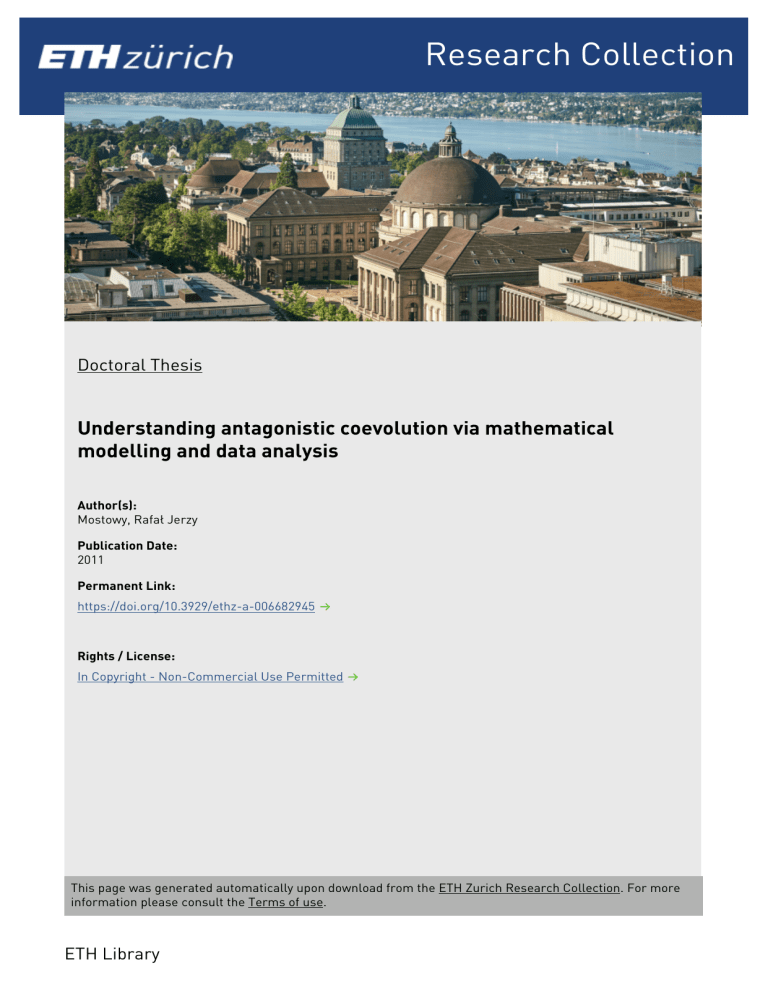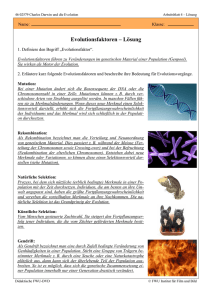dspace cover page - ETH E
Werbung

Research Collection Doctoral Thesis Understanding antagonistic coevolution via mathematical modelling and data analysis Author(s): Mostowy, Rafał Jerzy Publication Date: 2011 Permanent Link: https://doi.org/10.3929/ethz-a-006682945 Rights / License: In Copyright - Non-Commercial Use Permitted This page was generated automatically upon download from the ETH Zurich Research Collection. For more information please consult the Terms of use. ETH Library DISS. ETH NO. 19770 Understanding antagonistic coevolution via mathematical modelling and data analysis A dissertation submitted to ETH ZURICH for the degree of Doctor of Sciences presented by RAFAŁ JERZY MOSTOWY M.Sc., University of Copenhagen born 22nd of October, 1983 citizen of Poland Accepted on the recommendation of Prof. Sebastian L. Bonhoeffer, examiner Prof. Mike Boots, co-examiner 2011 Summary Parasites are ubiquitous organisms which evolve to exploit their hosts in an efficient way. Hosts, on the other hand, are under selective pressure to resist their parasites. The resulting reciprocal selective pressure is predicted to lead to genotype or phenotype frequency changes over time, a process called antagonistic coevolution. This form of coevolution can take different forms, one of them leading to negative frequency-dependent selection. Under this type of selection, cyclic genotype or phenotype frequency dynamics are expected to occur, promoting coexistence of different types in a population. The implications of such dynamic polymorphism are numerous and of great importance in ecology, veterinary and biomedical sciences, genetics, agriculture, and conservation biology. Studies of host-parasite coevolution can be subdivided into two main parts. One fraction of these studies is concerned with observing the nature of antagonistic coevolution, either in the lab or in the wild; the recognition of the coevolutionary process governing antagonistic interactions is of fundamental importance to understanding the genetic and non-genetic change in biological systems. Most of the remaining studies are concerned with the consequences of antagonistic coevolution on the evolution of traits of both species involved in those interactions, like the evolution of resistance, virulence, or the evolution of sexual reproduction. In this thesis, I address problems concerned with both branches of these studies. In part I of the thesis (chapters 2-3), I use population genetic models to explore the factors which might hinder the cyclic genotype or phenotype frequency dynamics in spite of the presence of negative frequency-dependent selection. Chapter 2 considers the impact of external environmental factors on host-parasite interactions, and how changes in such factors can alter the coevolutionary dynamics of the two antagonists. Chapter 3 examines the impact of non-genetic transmission of specific immunity on the observed cyclic phenotype frequency patterns. In part II of the thesis (chapters 4-6), I employ a mixture of population genetic and population dynamic approaches to understand the problems concerned with the evolution of sex in the context of antagonistic interactions. In chapter 4, I consider a model of a population of hosts interacting with the population with multiple parasites, and examine how an increased and complex interaction space affects the spread vii viii of recombination modifiers in the host population. Chapter 5 analyses the evolution of infection-dependent sex and examines under what conditions recombining at a higher rate when infected can explain the maintenance of sexual reproduction. Chapter 6 looks at the role of recombination in a specific context of the coevolution of HIV with the immune response. In part III of the thesis (chapter 7), I quantify the evolutionary cost of escape of HIV from the recognition by the immune system. This chapter provides a direct measurement of one of the crucial parameters of a system which undergoes rapid antagonistic coevolution. In the final part IV of the thesis (chapter 8), I give an example of other work I have performed in addition to working on this thesis. However, this work goes beyond the scope of this dissertation. Zusammenfassung Parasiten sind universelle Organismen, die sich fortwährend entwickeln um ihre Wirte in effizienter Weise auszunutzen. Andererseits sind die Wirte selektivem Druck ausgesetzt, um diesen Parasiten zu widerstehen. Man nimmt an, dass der daraus resultierende gegenseitige selektive Druck mit der Zeit zu einer Veränderung der Genotyp- oder Phänotyphäufigkeiten führt. Dieser Prozess wird antagonistische Koevolution genannt. Diese Form der Koevolution kann unterschiedliche Formen annehmen, eine davon führt zu negativ frequenzabhängiger Selektion. Bei dieser Art der Selektion können zyklische Dynamiken der Genotyp- oder Phänotyphäufigkeiten auftreten, die die Koexistenz verschiedener Typen in einer Population fördern. Die Auswirkungen eines solchen dynamischen Polymorphismus sind zahlreich und von grosser Bedeutung in der Ökologie, Veterinär-und Biomedizin, Genetik, Landwirtschaft und für den Naturschutz. Studien der Koevolution zwischen Wirten und Parasiten können in zwei Hauptbereiche gegliedert werden. Ein Teil dieser Untersuchungen befasst sich mit der Beschaffenheit der antagonistischen Koevolution, entweder im Labor oder in der freien Natur. Die Erfassung der koevolutionären Prozesse, die die antagonistischen Wechselwirkungen regeln, ist von fundamentaler Bedeutung für das Verständnis der genetischen und nicht-genetischen Veränderungen in den biologischen Systemen. Die meisten der übrigen Studien beschäftigen sich mit den Folgen der antagonistischen Koevolution auf die Entwicklung der Merkmale beider Arten, die an diesen Wechselwirkungen beteiligt sein. Dies schliesst zum Beispiel die Entwicklung von Resistenzen, Virulenz, oder die Evolution der sexuellen Fortpflanzung ein. In dieser Arbeit befasse ich mich mit Problemen aus beiden Bereichen dieser Studien. In Teil I der Arbeit (Kapitel 2-3) verwende ich populationsgenetische Modelle, um die Faktoren zu erforschen, die trotz der Anwesenheit von negativ frequenzabhängiger Selektion die zyklische Dynamik der Genotyp- oder Phänotyphäufigkeiten behindern könnten. Kapitel 2 betrachtet die Auswirkungen von externen Umweltfaktoren auf die Wirt-Parasit-Interaktionen und wie Veränderungen in diesen Faktoren die koevolutionäre Dynamik der beiden Antagonisten beeinflussen. Kapitel 3 untersucht die Auswirkungen der nicht-genetischen übertragung der spezifischen Immunität auf die beobachteten zyklischen Phänotypfrequenzmuster. ix x In Teil II der Dissertation (Kapitel 4-6) verwende ich eine Mischung aus populationsgenetischen und populationsdynamischen Ansätzen, um die Probleme zu verstehen, die mit der Evolution von Sex im Rahmen der betreffenden antagonistischen Interaktionen auftreten. In Kapitel 4 betrachte ich ein Modell in dem eine Wirtspopulation mit einer Population verschiedener Parasiten interagiert. Ich untersuche, wie ein vergröerter und komplexer Interaktionsbereich die Ausbreitung von Rekombinationsmodifikatoren in der Wirtspopulation beeinflusst. Kapitel 5 analysiert die Entwicklung von infektionsabhängigem Sex und untersucht, unter welchen Bedingungen eine erhöhte Rekombinationsrate bei Infektion die Aufrechterhaltung der sexuellen Fortpflanzung erklären kann. Kapitel 6 befasst sich mit der Rolle der Rekombination in einem spezifischen Zusammenhang der Koevolution von HIV mit der Immunantwort des Wirtes. In Teil III der Arbeit (Kapitel 7) quantifiziere ich die evolutionären Kosten die dem HI-Virus entstehen, wenn es sich der Immunabwehr des Wirtes entzieht. Dieses Kapitel liefert eine direkte Messung einer der entscheidenden Parameter eines Systems, welches einer schnellen antagonistischen Koevolution unterliegt. Im letzten Teil IV (Kapitel 8) gebe ich ein Beispiel für andere Arbeit, die ich zusätzlich zu den erwähnten Projekten geleistet habe. Allerdings geht diese Arbeit über den Rahmen der vorliegenden Dissertation hinaus.

